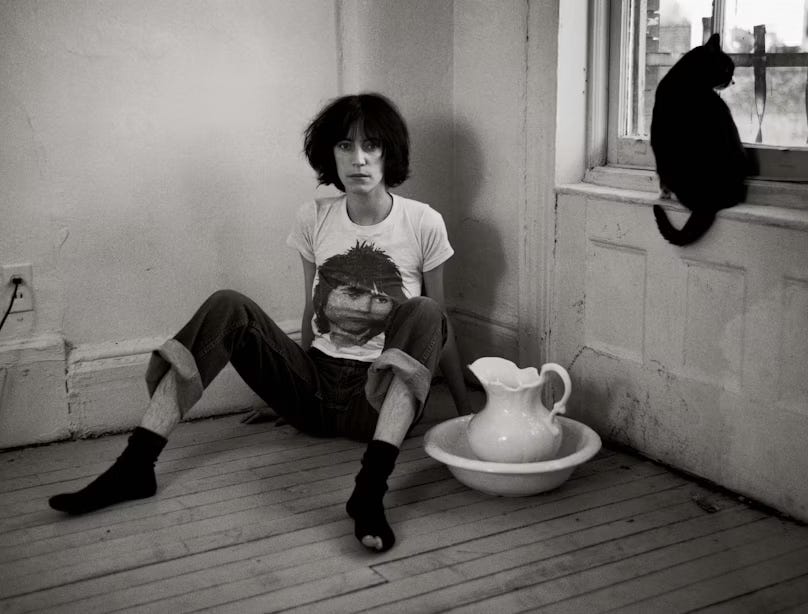Patti Smith's Literary Masterclass
a book review: analyzing the craft in "devotion: why i write"
I hadn’t really listened to, or read, any Patti Smith prior to reading Devotion: Why I Write.
But as I’m writing this, I’m listening to her debut Horses album. I’m googling, learning more about her history — how she became a pivotal figure in New York City’s punk rock scene, how she was born in Chicago but wound up living only an hour from me, attending Deptford Township High School. How she graduated from a New Jersey college, just like me. I learn her work explores themes of love, loss, and the human condition, and how she’s considered a trailblazer in both music and literature.
I’m falling a bit in love, I think.
Devotion: Why I Write by Patti Smith fell into my palms as I putzed around Farley’s Bookshop in Lambertville, New Jersey on a sunny yet frosty day in February.
I was struck first by the cover, an elegant, pensive black-and-white photograph of Smith. I scanned the interior sleeve:
In this stirring book, one of our culture’s most inspiring artists offers an intimate account of her own creative process.
Patti Smith presents an original and beautifully crafted tale of obsession: a young skater who lives for her art, a possessive collector who ruthlessly seeks his prize, a relationship forged of need both craven and exalted. A companion essay makes tangible the mysterious sources of this disquieting tale. Illumination comes as Smith journeys to the south of France to Camus’s house, tracks down Simone Weil’s grave in an Ashford cemetery on the outskirts of London, and haunts the winding nameless streets of Patrick Modiano’s Paris. Whether writing in a cafe or on a train, Smith generously opens her notebooks and lets us glimpse into the alchemy of her work in this arresting book on writing and why we write.
A book discussing writing and why we write?! Sign me up (each and every time). Devotion: Why I Write is short — about 93 pages, not including the last ‘Written on the Train’ section, which is filled with photographs of both Smith’s travels and handwritten pages.
Intrigued, I wondered: what gems would Smith choose to share in such a short book?
The book, part of Yale University Press’s Why I Write series, has a pretty unique structure as far as books-on-the-craft go. We are dropped into Smith’s life one evening as she watches a trailer for the film Risttuules, “translated as In the Crosswind.” Risttuules immediately sparks her inspiration; she begins writing. She muses, in hindsight, how her journaling was “the beginning of that something else, but I didn’t know it then.”
We follow Smith as she leaves for Paris. We’re taken to breakfast, work events, dinner, and walks throughout cemeteries and the city. Her prose is marvelous, frank, and striking — reading each sentence is like unwrapping candies and delighting at the sweet, citrusy flavor beneath.
More seeds of inspiration materialize while she’s doing book signings and interviews, feeding this new story brewing in her mind. And then Smith shows us how she writes by inserting said inspired short story smack in the middle of the book.
Now, I’ve seen the reviews — a lot of people don’t like the short story. I get it. I am not a fan of the plot (here’s your trigger warning: it involves a relationship between an older man and a much younger girl) and I found the characters unlikable.
But I wasn’t reading the short story for enjoyment. It’s a book on writing, so I was analyzing the craft. How was she introducing the characters? How did she show their motivations? How did her writing suddenly become film-like, as if I’m right there, in the moment?
If you can’t get to that point, again, I get it. But if it’s not triggering for you, I recommend approaching it in this mindset. As an English major, I’ve read my fair share of weird, uncomfortable short stories and novellas. Even the ones I disliked plot-wise or character-wise usually taught me something. And Smith’s did, too.
Take this character’s introduction:
He was a solitary man, in his late thirties, of unusual control, hardy and virile, yet uniquely sensitive, having already negotiated the spectrum of academics, risk, art, and excess. A dealer in artifacts, rare manuscripts, and arms, he could easily identify the age and origin of an obscure ivory feel, by the way it absorbed or reflected light. The valuable he delivered to museums; the exquisite he kept for himself. He had traveled extensively though not in leisurely fashion. His trunks contained a wealth of objects that when sold would add considerably to his fortune. He had done well, but the thrill of attainment had become hollow; he found himself uncharacteristically restless and short-tempered.
Smith paints a complex, uniquely sensitive man in his late thirties, who is physically strong and self-disciplined. We know he’s an expert in his field, well-rounded and adventurous; we can assume he has dual values — he gives to museums but keeps the rarest items for himself. We know he’s wealthy. And immediately this colors in what the character’s possible motives are and what could possibly drive his actions throughout this short story.
Smith encapsulates her characters time and again. Not just with our older male character, but with the young skater, and even the aunt, who is not at the forefront of the story but continuously haunts the sidelines.
But character introductions and descriptions aren’t Smith’s only strength.
We’re also given delicious prose:
It had always been difficult to draw anything out of her, though sometimes, when she had too much vodka, she would speak about the song of the wolves, the ice-covered trees, or the scent of the pink-and-white flowers that covered everything in spring.
And snappy, character-revealing action and dialogue:
“Open it,” he said. “It was a gift from a Czar to an Empress.”
Inside was a tiny Imperial coach, perfectly wrought in gold. He placed the coach in her hand, watching her reaction.
“Guess my name,” she said.
“There are many names.”
“But I have the name of a queen.”
“There are many queens.”
I chose this dialogue in particular because I love how this conversation suggests a subtle power play between the two characters: the man’s need to watch her reaction, giving her a symbolically rare and powerful gift; the girl’s playful deflection, suggesting that she herself is rare and powerful. Her name is a queen’s name, after all. We can dig into the psyche of the characters, feel the tug and pull between the two of them.
Did I mention I love it? Less can be more. Each word packs a punch.
And besides the Devotion short story, we do get some time with Smith as she speaks to us readers directly.
Here, Smith summarizes how she came to write this short story:
Fate has a hand but is not the hand. I was looking for something and found something else…
I began to write Devotion on the train from Paris to Sete. Initially I thought to compose a heightened discourse between disparate voices - a sophisticated, rational man and a precocious, intuitive young girl. I was interested to see where they would lead each other, forming an alliance in a realm of opulence and obscurity. I had also kept a loosely formed travel diary: pits of poems, notes, and observations for no particular reason save to write. Looking back on these fragments, I am struck with the thought that if Devotion was a crime, I had inadvertently produced evidence, annotating as I went along.
Most often the alchemy that produces a poem or a work of fiction is hidden within the work itself, if not embedded in the coiling ridges of the mind.
So what are my takeaways? And what does Patti Smith show us through Devotion: Why I Write?
Devotion: Why I Write is a top book I’d recommend on the craft of writing and literature. I adore Patti Smith’s style and language.
Smith shows us how life permeates into your psyche and births an inspired piece of work. She demonstrates wonderful character introductions, where each word and sentence gives you a glimpse into the character’s inner world and how they present to the outer world. She shows us how each word is a building block for an empire of rich language. How to include bold, undeniable honesty in your writing. Most of this is taught by demonstrating her skills in the short story and her journals, though she drives these teachings home by breaking the fourth wall and speaking to us directly, too.
My only criticism is I’d like more. Especially of Smith breaking the fourth wall. I plan to read more of her work to continue analyzing her writing style, but I love the direct feedback writers, poets, and creatives give. I find it’s rare and invaluable, and I’m always craving more of that.
Would I recommend it for the sake of the plot of the short story itself? Meh, not really.
But as I said earlier, when you’re approaching a piece to study the craft, liking the story is somewhat irrelevant. I’ll forever die on this hill — to learn the craft of writing, you must read. The good, the bad, the ugly, and everything in-between.
If you’ve read Devotion, what are your thoughts? Did you find it valuable or inspiring?
I’ll leave you with this —
When analyzing a piece of writing, consider asking these questions to deepen your understanding of the craft:
How are the characters introduced? What do their introductions reveal about them?
How do the characters’ motivations and actions drive the plot?
How is the story structured? How does the pacing affect its impact?
Can you identify central themes? How are they developed and presented to you, the reader?
How does the author use descriptive language? Does this create vivid settings, tell us about the characters, and/or evoke emotions?
How does the author’s style contribute to the overall tone and mood of the piece?
What emotions did the work evoke in you as a reader?
Please let me know if you liked this post, and if you’d like me to review more books on writing as a craft!
Thank you for taking the time to read with me today.
Follow my writing journey on my socials for more poems, updates & community interactions:
with love, amy elizabeth











okay i want to read this book now pls let me borrow it!!! 😭 your book reviews are incredible
Thank you for writing this! I'm so intrigued and NEED to read this book asap.